-
036-第三代软件开发-系统时间设置

第三代软件开发-系统时间设置
关键字:Qt、Qml、Time、时间、系统项目介绍
欢迎来到我们的 QML & C++ 项目!这个项目结合了 QML(Qt Meta-Object Language)和 C++ 的强大功能,旨在开发出色的用户界面和高性能的后端逻辑。
在项目中,我们利用 QML 的声明式语法和可视化设计能力创建出现代化的用户界面。通过直观的编码和可重用的组件,我们能够迅速开发出丰富多样的界面效果和动画效果。同时,我们利用 QML 强大的集成能力,轻松将 C++ 的底层逻辑和数据模型集成到前端界面中。
在后端方面,我们使用 C++ 编写高性能的算法、数据处理和计算逻辑。C++ 是一种强大的编程语言,能够提供卓越的性能和可扩展性。我们的团队致力于优化代码,减少资源消耗,以确保我们的项目在各种平台和设备上都能够高效运行。
无论您是对 QML 和 C++ 开发感兴趣,还是需要我们为您构建复杂的用户界面和后端逻辑,我们都随时准备为您提供支持。请随时联系我们,让我们一同打造现代化、高性能的 QML & C++ 项目!
重要说明☝
☀该专栏在第三代软开发更新完将涨价
系统时间设置
因为Qt目前好像没有针对这个的库,所以目前的实现是基于Linux的,准确是是Ubuntu22.04版本。
演示效果
这是来之我们公司小伙伴的作品,我们今天就学习一下。顺带Review一下,看看能不能发现什么BUG。

其实之前这位小伙伴搞复杂了,想着用什么控件啥的,其实Linux是啥,最便捷的就只指令代码,我最开始给他的就是前端qml吧界面撸出来,后端发个指令设置下时间就OK了,不过看他第一版的时候好像整了不少东西,后面好像改成指令。
QML 实现
你看看,少叮嘱一句也不行,上来就给我手撸一个
Tumbler;
这里要给大家推荐一下
Qt Desing Studio,不是说这个有多香,反正我是不喜欢用,qml 我都是纯手撸代码,如果我们不知道一个东西Qt 到底有没有给我们实现的时候,可以用它看看。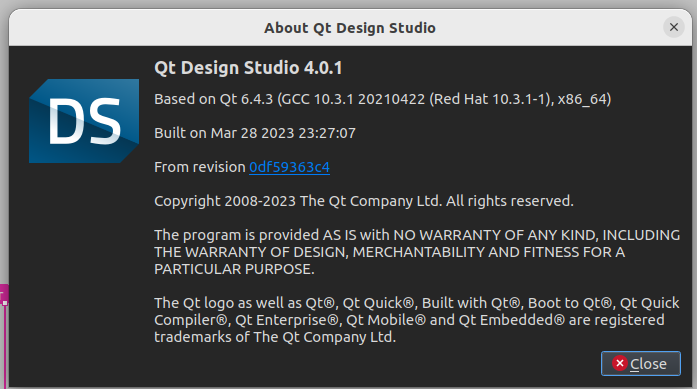
你看,这不Qt已经为咱们写了吗。
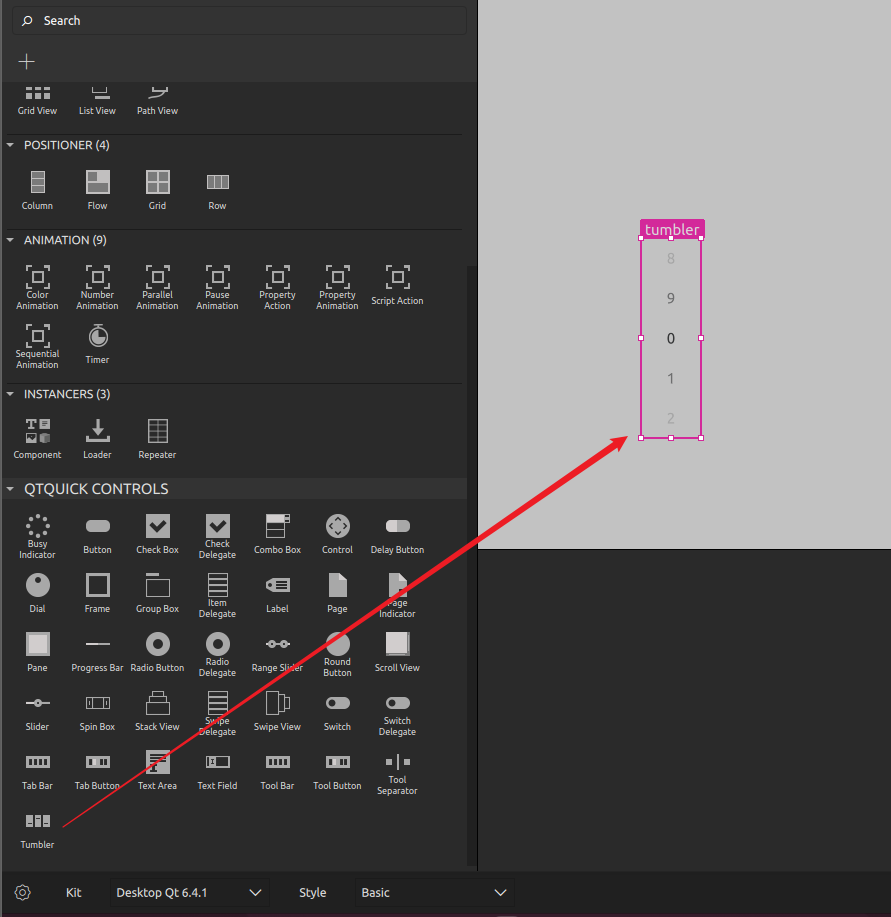
不过小伙伴写都写了,咱们还是看一下吧
小伙伴自创 Tumbler
import QtQuick 2.12 import QtQuick.Layouts 1.12 Rectangle { id: rootRec color: "transparent" property int min: -1 property int max: -1 property int current: -1 property int zero: 0 //获取最终结果 function getResult(){ return (myPathView.currentIndex + root.min) } ColumnLayout{ anchors.fill: parent Item { Layout.fillHeight: true Layout.fillWidth: true Layout.margins: 10 PathView{ id: myPathView anchors.fill: parent currentIndex: (-1 === rootRec.current) ? 0 : (rootRec.current - rootRec.min) onCurrentIndexChanged: { rootRec.current = currentIndex + rootRec.min; } model: (rootRec.max - rootRec.min + 1) delegate: Item{// width:myPathView.width/2 height:myPathView.height/myPathView.pathItemCount scale: PathView.iconScale!==undefined?PathView.iconScale:1 opacity: PathView.iconOpacity!==undefined?PathView.iconOpacity:1 z:PathView.iconZ!==undefined?PathView.iconZ:1 transform: Rotation { origin.x: width/2 origin.y: height/2 axis.x: 1 axis.y: 0 axis.z: 0 angle: PathView.iconAngle!==undefined?PathView.iconAngle:0 } Text{ id:timeText anchors.centerIn: parent text: String(Number(modelData) + rootRec.min).padStart(rootRec.zero, '0') color: PathView.isCurrentItem ? "#0099ff" : Qt.lighter("#FFFFFF") font.pixelSize: 20 verticalAlignment: Text.AlignVCenter horizontalAlignment: Text.AlignHCenter } } pathItemCount: 5 preferredHighlightBegin: 0.5 preferredHighlightEnd: 0.5 highlightRangeMode: PathView.StrictlyEnforceRange //交互属性,支持拖动等…… interactive: true //滑动速度 maximumFlickVelocity:100 path :pathVertical Path{//------------垂直变化------------ id:pathVertical property int height: myPathView.height startX: myPathView.width/2 PathLine { id:line1; x: pathVertical.startX; y: pathVertical.startY; } PathAttribute { name: "iconZ"; value: 1 } PathAttribute { name: "iconScale"; value: 0.6 } PathAttribute { name: "iconOpacity"; value: 0.3 } PathAttribute { name: "iconAngle"; value: 80 } PathPercent { value: 0 } // start scaling up PathLine { id:line2; x: line1.x; y: line1.y + pathVertical.height; } PathAttribute { name: "iconZ"; value: 2 } PathAttribute { name: "iconScale"; value: 0.8 } PathAttribute { name: "iconOpacity"; value: 0.4 } PathAttribute { name: "iconAngle"; value: 50 } PathPercent { value: 1/4 } // middle point PathLine { x: line2.x; y: line2.y; } PathAttribute { name: "iconZ"; value: 5 } PathAttribute { name: "iconScale"; value: 1.0 } PathAttribute { name: "iconOpacity"; value:1.0 } PathAttribute { name: "iconAngle"; value: 0 } PathPercent { value: 2/4} // start scaling down PathLine { x: line2.x; y: line2.y; } PathAttribute { name: "iconZ"; value: 2 } PathAttribute { name: "iconScale"; value: 0.8} PathAttribute { name: "iconOpacity"; value: 0.4 } PathAttribute { name: "iconAngle"; value: -50 } PathPercent { value: 3/4 } // last point PathLine { x: line2.x; y: line2.y; } PathAttribute { name: "iconZ"; value: 1 } PathAttribute { name: "iconScale"; value: 0.6 } PathAttribute { name: "iconOpacity"; value:0.3 } PathAttribute { name: "iconAngle"; value: -80 } PathPercent { value: 1} } } } } }- 1
- 2
- 3
- 4
- 5
- 6
- 7
- 8
- 9
- 10
- 11
- 12
- 13
- 14
- 15
- 16
- 17
- 18
- 19
- 20
- 21
- 22
- 23
- 24
- 25
- 26
- 27
- 28
- 29
- 30
- 31
- 32
- 33
- 34
- 35
- 36
- 37
- 38
- 39
- 40
- 41
- 42
- 43
- 44
- 45
- 46
- 47
- 48
- 49
- 50
- 51
- 52
- 53
- 54
- 55
- 56
- 57
- 58
- 59
- 60
- 61
- 62
- 63
- 64
- 65
- 66
- 67
- 68
- 69
- 70
- 71
- 72
- 73
- 74
- 75
- 76
- 77
- 78
- 79
- 80
- 81
- 82
- 83
- 84
- 85
- 86
- 87
- 88
- 89
- 90
- 91
- 92
- 93
- 94
- 95
- 96
- 97
- 98
- 99
- 100
- 101
- 102
- 103
- 104
- 105
- 106
- 107
- 108
- 109
- 110
- 111
- 112
- 113
- 114
- 115
- 116
- 117
- 118
- 119
- 120
Qt 家 Tumbler
通过帮助文档,咱们可以看到有两个版本的 Tumbler,如下图所示
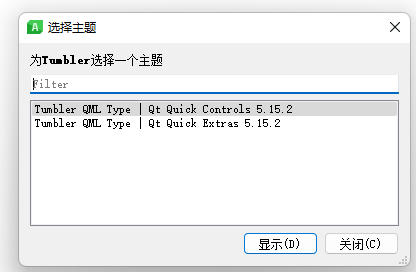
- Controls 版本
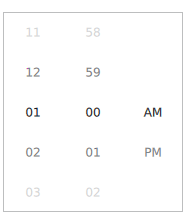
示例代码如下:
import QtQuick 2.12 import QtQuick.Window 2.2 import QtQuick.Controls 2.12 Rectangle { width: frame.implicitWidth + 10 height: frame.implicitHeight + 10 function formatText(count, modelData) { var data = count === 12 ? modelData + 1 : modelData; return data.toString().length < 2 ? "0" + data : data; } FontMetrics { id: fontMetrics } Component { id: delegateComponent Label { text: formatText(Tumbler.tumbler.count, modelData) opacity: 1.0 - Math.abs(Tumbler.displacement) / (Tumbler.tumbler.visibleItemCount / 2) horizontalAlignment: Text.AlignHCenter verticalAlignment: Text.AlignVCenter font.pixelSize: fontMetrics.font.pixelSize * 1.25 } } Frame { id: frame padding: 0 anchors.centerIn: parent Row { id: row Tumbler { id: hoursTumbler model: 12 delegate: delegateComponent } Tumbler { id: minutesTumbler model: 60 delegate: delegateComponent } Tumbler { id: amPmTumbler model: ["AM", "PM"] delegate: delegateComponent } } } }- 1
- 2
- 3
- 4
- 5
- 6
- 7
- 8
- 9
- 10
- 11
- 12
- 13
- 14
- 15
- 16
- 17
- 18
- 19
- 20
- 21
- 22
- 23
- 24
- 25
- 26
- 27
- 28
- 29
- 30
- 31
- 32
- 33
- 34
- 35
- 36
- 37
- 38
- 39
- 40
- 41
- 42
- 43
- 44
- 45
- 46
- 47
- 48
- 49
- 50
- 51
- 52
- 53
- 54
- 55
- 56
- 57
当然,我们也可以自定义 Tumbler,官方示例如下:
import QtQuick 2.12 import QtQuick.Controls 2.12 Tumbler { id: control model: 15 background: Item { Rectangle { opacity: control.enabled ? 0.2 : 0.1 border.color: "#000000" width: parent.width height: 1 anchors.top: parent.top } Rectangle { opacity: control.enabled ? 0.2 : 0.1 border.color: "#000000" width: parent.width height: 1 anchors.bottom: parent.bottom } } delegate: Text { text: qsTr("Item %1").arg(modelData + 1) font: control.font horizontalAlignment: Text.AlignHCenter verticalAlignment: Text.AlignVCenter opacity: 1.0 - Math.abs(Tumbler.displacement) / (control.visibleItemCount / 2) } Rectangle { anchors.horizontalCenter: control.horizontalCenter y: control.height * 0.4 width: 40 height: 1 color: "#21be2b" } Rectangle { anchors.horizontalCenter: control.horizontalCenter y: control.height * 0.6 width: 40 height: 1 color: "#21be2b" } }- 1
- 2
- 3
- 4
- 5
- 6
- 7
- 8
- 9
- 10
- 11
- 12
- 13
- 14
- 15
- 16
- 17
- 18
- 19
- 20
- 21
- 22
- 23
- 24
- 25
- 26
- 27
- 28
- 29
- 30
- 31
- 32
- 33
- 34
- 35
- 36
- 37
- 38
- 39
- 40
- 41
- 42
- 43
- 44
- 45
- 46
- 47
- 48
- 49
这里还有两个更高级的版本,不过我没有用过,咱们帖一下,占点字符空间哈
If you want to define your own contentItem, use either a ListView or PathView as the root item. For a wrapping Tumbler, use PathView:
Tumbler { id: tumbler contentItem: PathView { id: pathView model: tumbler.model delegate: tumbler.delegate clip: true pathItemCount: tumbler.visibleItemCount + 1 preferredHighlightBegin: 0.5 preferredHighlightEnd: 0.5 dragMargin: width / 2 path: Path { startX: pathView.width / 2 startY: -pathView.delegateHeight / 2 PathLine { x: pathView.width / 2 y: pathView.pathItemCount * pathView.delegateHeight - pathView.delegateHeight / 2 } } property real delegateHeight: tumbler.availableHeight / tumbler.visibleItemCount } }- 1
- 2
- 3
- 4
- 5
- 6
- 7
- 8
- 9
- 10
- 11
- 12
- 13
- 14
- 15
- 16
- 17
- 18
- 19
- 20
- 21
- 22
- 23
- 24
- 25
For a non-wrapping Tumbler, use ListView:
Tumbler { id: tumbler contentItem: ListView { model: tumbler.model delegate: tumbler.delegate snapMode: ListView.SnapToItem highlightRangeMode: ListView.StrictlyEnforceRange preferredHighlightBegin: height / 2 - (height / tumbler.visibleItemCount / 2) preferredHighlightEnd: height / 2 + (height / tumbler.visibleItemCount / 2) clip: true } }- 1
- 2
- 3
- 4
- 5
- 6
- 7
- 8
- 9
- 10
- 11
- 12
- 13
- 14
- Extras版本
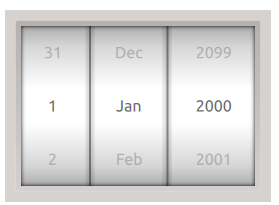
官方示例如下:
The Tumbler control is used with one or more TumblerColumn items, which define the content of each column:
Tumbler { TumblerColumn { model: 5 } TumblerColumn { model: [0, 1, 2, 3, 4] } TumblerColumn { model: ["A", "B", "C", "D", "E"] } }- 1
- 2
- 3
- 4
- 5
- 6
- 7
- 8
- 9
- 10
- 11
You can also use a traditional model with roles:
Rectangle { width: 220 height: 350 color: "#494d53" ListModel { id: listModel ListElement { foo: "A" bar: "B" baz: "C" } ListElement { foo: "A" bar: "B" baz: "C" } ListElement { foo: "A" bar: "B" baz: "C" } } Tumbler { anchors.centerIn: parent TumblerColumn { model: listModel role: "foo" } TumblerColumn { model: listModel role: "bar" } TumblerColumn { model: listModel role: "baz" } } }- 1
- 2
- 3
- 4
- 5
- 6
- 7
- 8
- 9
- 10
- 11
- 12
- 13
- 14
- 15
- 16
- 17
- 18
- 19
- 20
- 21
- 22
- 23
- 24
- 25
- 26
- 27
- 28
- 29
- 30
- 31
- 32
- 33
- 34
- 35
- 36
- 37
- 38
- 39
- 40
- 41
- 42
- 43
- 44
C++ 端实现
哎,甭管那些了,总之目前是实现了功能了,咱们还是看看C++端的实现代码吧,后期如果有机会,我在尝试下
/** * @brief XXXX::updateTime * @param strTime * @return * 更新时间 */ int XXXX::updateTime(QString strTime) { QString strDate = strTime.split(" ").at(0); QString strTimer = strTime.split(" ").at(1); QString year = strDate.split("-").at(0); //年 QString month = strDate.split("-").at(1); //月 QString day = strDate.split("-").at(2); //日 QString hour = strTimer.split(":").at(0); //时 QString min = strTimer.split(":").at(1); //分 QString second = strTimer.split(":").at(2); //秒 QString a = "date -s" + year + "/" + month + "/" + day; QString b = "date -s" + hour + ":" + min + ":" + second; char *ch; QByteArray ba = a.toLatin1(); ch = ba.data(); char *ch_2; QByteArray ba_2 = b.toLatin1(); ch_2 = ba_2.data(); system(ch); system(ch_2); //强制写入到CMOS system("hwclock -w"); return 1; }- 1
- 2
- 3
- 4
- 5
- 6
- 7
- 8
- 9
- 10
- 11
- 12
- 13
- 14
- 15
- 16
- 17
- 18
- 19
- 20
- 21
- 22
- 23
- 24
- 25
- 26
- 27
- 28
- 29
- 30
- 31
- 32
- 33
- 34
- 35
- 36
- 37
如我所愿,最后还是还是用了指令的方式实现了。
总结一下
不尽人意。目前功能开发工作量比较大,先这么滴吧,以实现功能优先,后期再重构。目前这个我也只能分享官方的示例代码,我没有实际写过这个模块。小弟也没有问我,而我也在忙着撸自己的KPI,没有及时Review他的代码,看到实现功能就给过了,没想到呀,不过其实也如你所愿,可能我们的领导并不关注我们的实现方式是否合理,在某一特定条件下,他可能更看重结果。不顾纸是包不住火的,在他时间宽裕的时候,总是会在回头看看的,所以小伙伴们,在条件的允许的情况下,还是要确保你的代码尽可能的合理。

-
相关阅读:
FPGA项目开发之同步信号和亚稳态
springboot - 2.7.3版本 - (二)整合Redis
linux 自带压力测试工具ab
ps制作gif动图
在 Electron上安装better-sqlite3出错
python3中的宏HAVE_VFORK
docker启动命令,docker重启命令,docker关闭命令
三种方式部署单机版Minio,10行命令干就完了~
信息系统供应商保密协议
SQLSERVER基础--数据库基础
- 原文地址:https://blog.csdn.net/z609932088/article/details/134097217